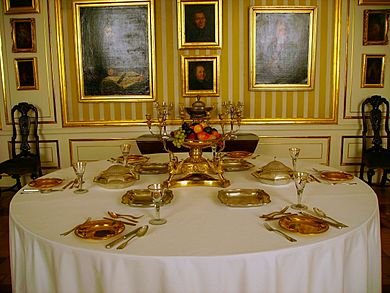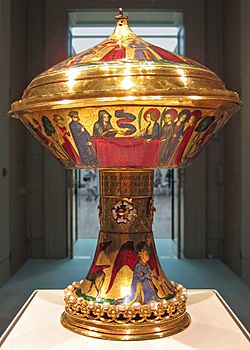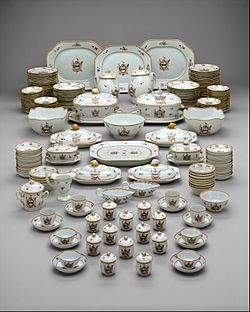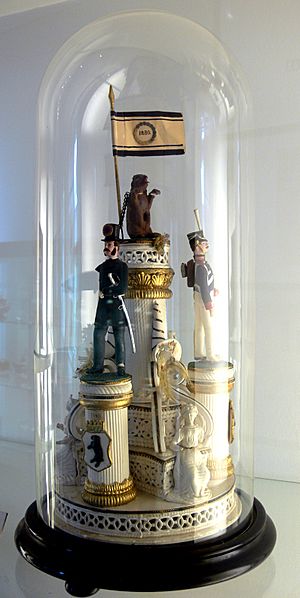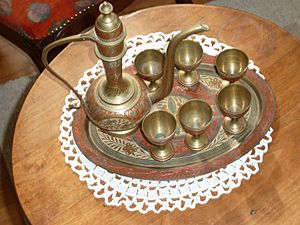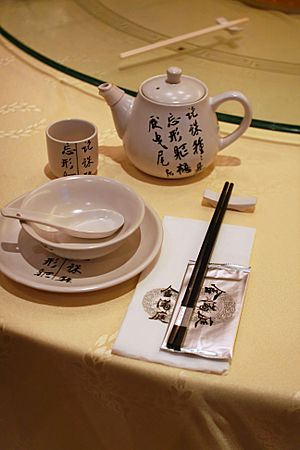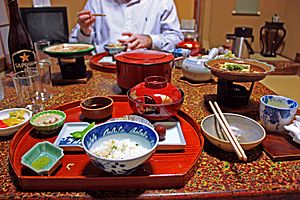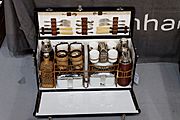Tableware facts for kids
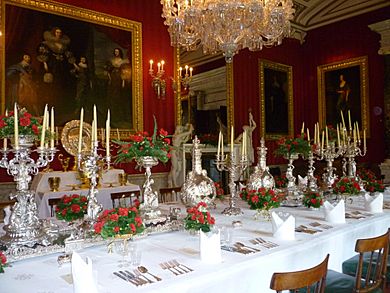
Tableware includes all the dishes and items you use to set a table, serve food, and eat your meals. This includes things like cutlery (forks, spoons, knives), glasses, serving bowls, and other items that are both useful and decorative. The type, quality, and amount of tableware can change a lot based on different cultures, religions, how many people are eating, what kind of cuisine (food style) is served, and the specialness of the event. For example, in some Middle Eastern, Indian, or Polynesian cultures, people might only use serving dishes and eat with bread or leaves instead of individual plates. Special events often use nicer tableware.
In the United States, cutlery is often called silverware or flatware, while cutlery usually means just knives. In other places, cutlery means all forks, spoons, and other silverware. Outside the US, flatware refers to open dishes like plates and bowls. Dinnerware is another word for tableware, and crockery means ceramic tableware, like porcelain or bone china. A full set of dishes is called a table service or dinner service. A place setting is the collection of dishes, cutlery, and glasses for one person. In Ireland, these items are sometimes called delph, which comes from the town of Delft where a lot of pottery was made. Silver service or butler service are special ways that a waiter serves a meal.
Setting the table means arranging the tableware, including a place setting for each person, and decorating the table to fit the occasion. Tableware and decorations are usually more detailed for special events. If you're eating in an unusual place, like outdoors, the tableware needs to be different.
Contents
What Is Tableware Made From?
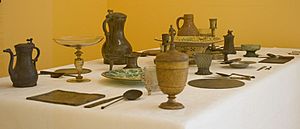
For the last few centuries, most flatware (plates, bowls) has been made from pottery or ceramic materials like earthenware, stoneware, bone china, or porcelain. Ceramics became very popular because of ceramic glazes, which give pottery a smooth, glassy surface. Without this glaze, pottery tableware might not be as clean. Tableware can also be made from other materials like wood, pewter, silver, gold, glass, acrylic, and plastic. Before factories could mass-produce tableware, people made it from materials they had, like wood. Thanks to factories and new ways of making ceramics, affordable, washable tableware became widely available.
Tableware is sold either by the piece or as a matching set for a certain number of people, usually four, six, eight, or twelve. Restaurants buy large amounts of it. If you need to replace a broken dish, you can often find individual pieces in stores or from antique dealers if the design is no longer made.
Cutlery (forks, spoons, knives) is usually made of metal. However, larger serving pieces like ladles might be made of wood.
A Look Back: How Tableware Changed
Plates and Bowls Through Time
The very first pottery made by ancient cultures didn't seem to include flat plates. Instead, they focused on pots and jars for storing and cooking food. Wood doesn't last long in the ground, so archaeologists haven't found many wooden plates from ancient times, but they were probably common once people had tools to make them.
In most ancient cultures, wealthy people preferred to eat from dishes made of precious metals like silver or gold. China and Japan were different; they used lacquerware (items coated with a special varnish) and later fine pottery, especially porcelain. In China, bowls have always been more popular than flat plates. In Europe, pewter was often used by less wealthy people, and silver or gold by the rich. Religious beliefs also affected what materials were used. For example, Muhammad spoke against using gold at the table, which encouraged the growth of Islamic pottery.
In Europe, rich people ate from metal dishes, usually silver, from ancient Greek and Roman times until the 1700s. A trencher was a large flat piece of bread or wood. In the Middle Ages, this was a common way to serve food, and the bread was often eaten too. Even in fancy dining, bread trenchers weren't fully replaced in France until the 1650s, though Italy started using maiolica (a type of pottery) in the 1400s. Records show huge sets of dishes were used. At an Este family wedding in Ferrara in 1565, 12,000 plates painted with the family's symbol were used, though the most important guests probably ate from precious metal.
Having tableware has always depended on how wealthy a person was. The richer you were, the better quality and more pieces of tableware you owned. Laws sometimes even controlled what materials people could use. In the late Middle Ages and early modern times, much of a wealthy person's money was often in "plate"—vessels and tableware made of precious metal. What wasn't being used for a meal was often shown off on a special display cabinet called a dressoir or buffet in the dining hall. At the wedding of Philip the Good, Duke of Burgundy, in 1429, there were two dressers, each 20 feet long, with five rows of plate. King Charles V of France (who ruled from 1364–1380) had 2,500 pieces of plate!
This precious metal tableware was often melted down to pay for wars or buildings, or simply to be remade in a newer style. Because of this, very little of the huge amounts of plate from the Middle Ages still exists today. The French Royal Gold Cup in the British Museum, made of solid gold with enamel and pearls, is one of the few exceptions. It weighs over two kilograms and was perhaps passed around for special toasts. Another example is the simpler English silver Lacock Cup, which survived because it was given to a church early on to be used as a chalice.
The same is true for French silver from the 150 years before the French Revolution. During this time, French styles were copied by royal families all over Europe. London silversmiths were also major exporters. Today, French silver from that period mostly survives as pieces that were exported to other countries, like the Germain Service made for the King of Portugal.
In 13th-century London, wealthier citizens had nice furniture and silver, while poorer people only had simple pottery and kitchen tools. By the late 1500s, even less wealthy citizens ate from pewter instead of wood and had dishes made from "green glazed earthenware." Noble families often had their family symbols on their heraldic china.
By the 1770s, porcelain tableware had replaced silver as the standard for fancy dining in France. After this, European porcelain and cheaper fine earthenware like faience and creamware became very popular. Also, large amounts of Chinese export porcelain, often decorated with family symbols, started coming into Europe again. This made matching "china" sets affordable for more and more people. By 1800, cheaper versions of these dishes were often brightly decorated with transfer printing (a way to print designs) in blue, and even better-off working-class families could afford them. Until the mid-1800s, the American market mostly bought tableware imported from Britain, with some from China and Europe.
The popularity of hot drinks like tea and coffee led to new types of tableware. When made of pottery, these items are often called teaware. They started appearing in the late 1600s. For a while, the serving pots, milk jugs, and sugar bowls were often silver, while the cups and saucers were ceramic, often from China or Japan. By the mid-1700s, matching sets of European "china" were common for all these items, though plates for cake didn't usually come with them until the next century. This shift to local china was a bit slow because some early European soft-paste porcelain could break if very hot liquid was poured into it.
The Story of Cutlery
The knife is the oldest type of cutlery. Early knives were usually carried by people all the time. Forks and spoons came later and were first used only by the very rich, who often carried their own personal sets. After the Romans, who used spoons a lot and later forks, most people in the Middle Ages only had knives and perhaps wooden spoons. It wasn't until the 1600s that wealthy hosts started to set out cutlery for their guests. However, at an Italian banquet in 1536 for Charles V, Holy Roman Emperor, it's noted that each guest received a knife, spoon, and fork, which was very rare at the time.
The table fork became popular again in Italy in the 1500s. An English traveler named Thomas Coryat described it in the 1590s as "not used in any other country that I saw in my travels." In England and France, forks only became common after the 1660s, even in the court of King Louis XIV. For a while, they seemed to be mostly used by ladies and for very messy foods, like fruits in syrup.
Decorating the Table
Tableware is usually for practical use, but people have always paid a lot of attention to how tables look, especially for special events like banquets given by important people or state occasions. Table decorations can be temporary, made from things like confectionery (sweets) or wax. These were common on Roman banquet tables in the 1600s. During the time of King George III, temporary table decorations were made by "table-deckers" who used sand and similar materials to create marmotinto (sand painting) designs that were only used once. Today, temporary table decorations are still made from sugar or carved from ice.
Porcelain figurines started in Germany in the early 1700s as a lasting replacement for sugar sculptures on dining tables. In wealthy countries like 17th-century France, table decorations for the rich were sometimes made of silver. One of the most famous silver table decorations is the Cellini Salt Cellar. Temporary and silver table decorations were replaced with porcelain items after porcelain was rediscovered in Europe in the 1500s.
Western Table Setting Styles
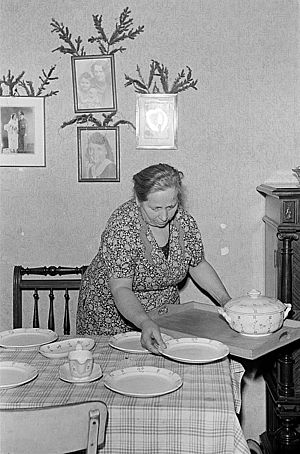
How Tables Are Set
In Western countries, tables are mainly set in two ways: service à la russe (French for "in the Russian style") and service à la française (French for "in the French style"). In service à la russe, each course of the meal is brought out one by one. In service à la française, all the dishes for the meal are placed on the table at the same time when guests sit down. Service à la russe is now common in most restaurants, while service à la française is typical for family meals at home.
For service à la russe dining, the tableware is arranged based on how many courses there are. Guests start by using the cutlery placed on the outside of their place setting. As each course is finished, the guest leaves the used cutlery on the plate, which is then taken away by the server. Sometimes, the original set of cutlery is kept for the next course. To start the next course, the diner uses the next item on the outside of the place setting, and so on. Forks are placed to the left of the dinner plate, knives to the right, and spoons to the far right.
Plates and Bowls for Each Person
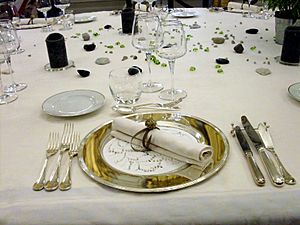
Tableware items include many kinds of plates, bowls, or cups for individual diners. There are also various serving dishes to bring food from the kitchen or to hold smaller portions. Plates include charger plates (large decorative plates under the main plate) as well as specific dinner plates, lunch plates, dessert plates, salad plates, or side plates. Bowls include those for soup, cereal, pasta, fruit, or dessert. A range of saucers go with plates and bowls, like those for teacups, coffee cups, demitasses (small coffee cups), and cream soup bowls. There are also individual covered casserole dishes.
Dishes come in standard sizes set by manufacturers, which are similar across the industry. Plates are standardized by their diameter (size across) based on their use. One common set of sizes is: charger (12 inches), dinner plate (10.5 inches), dessert plate (8.5 inches), salad plate (7.5 inches), and side plate or tea plate (6.75 inches).
Glasses and Drinkware
Glasses and mugs are a key part of tableware because drinks are important for a meal. Glasses for alcoholic drinks like wine (whether red, white, or sparkling) tend to have very specific shapes. For example, Port wine glasses, beer glasses, brandy balloons, aperitif glasses, and liqueur glasses all look different. Water glasses, juice glasses, and hot chocolate mugs also have distinct shapes. How they appear on the table depends on the meal and the style of table setting.
Tea and coffee often involve special social customs, so teacups and coffee cups (including demitasse cups) have shapes that depend on the culture and the social situation where the drink is served.
Cutlery: Forks, Spoons, and Knives
Cutlery is a very important part of tableware. A basic formal place setting usually has a dinner plate in the center, resting on a charger. The rest of the setting depends on the first course, which might be soup, salad, or fish.
- If soup is the first course, moving clockwise from the left of the dinner plate, you'll find: a small salad fork to the left of the dinner plate; a large dinner fork to the left of the salad fork; a side plate above the forks; a wine or water glass above and to the right of the dinner plate; a large dinner knife to the right of the dinner plate; a smaller butter knife to the right of the dinner knife; a dinner spoon to the right of the knives; and a soup spoon to the right of the dinner spoon.
- If salad is the first course, the soup spoon is not used. The dinner fork is placed right next to the dinner plate on the left, and the salad fork is placed on the far left side of the setting.
In both arrangements, the napkin can be folded and placed under the forks or on top of the dinner plate.
When more courses are served, place settings can become more detailed, and cutlery becomes more specialized. Examples include fruit spoons or knives, cheese knives, and pastry forks. Other types of cutlery, like boning forks, were used for formal meals that included dishes less common today. Carving knives and forks are used to cut roasts at the table.
Serving Dishes for the Table
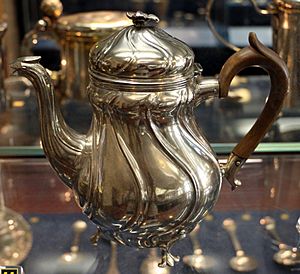
Many different serving dishes are used to bring food from the kitchen to the table or to serve it at the table. This makes serving food easier, cleaner, and more pleasant. Serving dishes include: butter dishes; casseroles; fruit bowls; ramekins (small baking dishes) or lidded serving bowls; compotes (dishes for fruit preserves); pitchers or jugs; platters, salvers (trays), and trays; salt and pepper shakers or salt cellars; sauce or gravy boats; tureens (large soup bowls) and tajines (cooking pots); and vegetable or salad bowls.
A variety of items specifically for serving tea or coffee also have long cultural traditions. These include teapots and coffee pots, as well as samovars (hot water urns), sugar bowls, and milk or cream jugs.
Place Markers: Showing Where to Sit
Place markers are used to show guests where they should sit. They are typically used at large formal events like weddings, banquets for important people (like politicians or diplomats), and special occasions like big children's parties. Some place markers are even collected by people.
Chinese Table Setting Style
Chinese table settings have a traditional style. Table setting practices in Japan and other parts of East Asia have been influenced by Chinese customs. In Chinese table settings, the focus is on making each individual food look nice, usually in separate bowls or dishes. Formal table settings are based on how families set their tables, though they can become very detailed with many dishes. Serving bowls and dishes are brought to the table, and guests can choose their own portions. Formal Chinese restaurants often use a large turning wheel in the center of the table to rotate food for easier serving.
In a family setting, a meal usually includes a fan dish, which is the main part of the meal (like bread in a sandwich), and several side dishes called cai (pronounced choi or seoung in Cantonese). Fan usually means cooked rice, but it can also be other grain-based foods. If the meal is light, it will typically have the main base and one side dish. The base is often served directly to the guest in a bowl, while main dishes are chosen by the guest from shared serving dishes on the table.
A detailed formal Chinese meal setting would include:
- A center plate, about 6 inches across.
- A rice bowl, placed to the right of the center plate.
- A small cup of tea, placed above the plate or rice bowl.
- Chopsticks to the right of the center plate, on a chopstick rest.
- A long-handled spoon on a spoon rest, placed to the left of the chopsticks.
- Small condiment dishes, placed above the center plate.
- A soup bowl, placed to the left above the center plate.
- A soup spoon, inside the soup bowl.
Japanese Table Setting Style
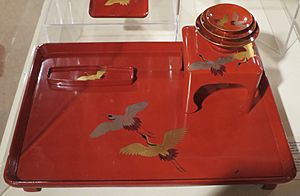
Japanese ceramic tableware has been made for many centuries. Unlike in Western cultures, where tableware is often bought in matching sets, Japanese tableware is arranged so that each dish looks good with the specific food served in it. Since Japanese meals usually include several small amounts of each food per person, this means each person has a place setting with many different small dishes and bowls for individual foods and sauces. The main goal of a Japanese table setting is to make the food look even better. This is partly done by showing contrasts between the items. Each bowl and dish might have a different shape, color, or pattern.
A basic complete place setting for one person in Japan would include:
- A hot noodle bowl.
- A rice bowl.
- A soup bowl.
- Two to three shallow dishes, 3 to 5 inches across.
- Two to three bowls, 3 to 5 inches across and 1 to 3 inches deep.
- Two square or rectangular pieces, traditionally used for serving fish.
- Three small condiment plates, 2 to 3 inches across.
- A Zaru (a cold noodle tray with a bamboo strainer).
- A dipping sauce cup.
- Chopsticks and a chopstick rest.
Not all of these plates and bowls would be needed for one meal. A typical meal might include a rice bowl, a soup bowl, two or three small dishes with side foods, and two or three condiment dishes per person. Various serving bowls and platters would also be on the table for a typical meal, along with a soy sauce cruet (small bottle), a small pitcher for tempura or other sauce, and a tea set with a teapot, teacups, and saucers.
Tableware for Special Situations
Tableware for special situations needs to be different. For example, eating outdoors, whether for fun like a picnic or as part of a trip or mission, requires special tableware. It must be easy to carry, stronger, and lighter than tableware used indoors. It is usually carefully packed to be transported to where it will be used.
Images for kids
-
Historic Pewter, faience and glass tableware
-
The Royal Gold Cup, 23.6 cm high, 17.8 cm across; weight 1.935 kg, British Museum. Saint Agnes appears to her friends in a vision. Before 1391, when it was owned by the King of France. One of a handful of medieval survivals, solid gold with enamels.
-
Setting the table for a family meal, Leipzig (1952)
-
Table laid out for a banquet in Toulouse at the Palais Niel (2010)
Plates Dinner plate with rolled table napkin; small bread plate above forks.
Glasses Small glass for water, larger one behind for red wine, and smaller wine glass for white wine.
Cutlery (from the outside toward the plate) Fish cutlery (knife and fork, as fish will be served without any sauce, otherwise it would be a fish spoon (cuillère à gourmet)); meat cutlery and cheese or fruit cutlery, the end of the knife rests on a knife rest. Above the plate, dessert cutlery (spoon and fork). -
The Vyborgian coffee pot from the 18th century on display in the National Museum of Finland
-
New Year sake set with images of cranes, lacquer on wood (Japan, late 19th century)
-
STS-129 crew members using specialised tableware for a meal in the International Space Station (2009)
-
Business-class airline meal with tightly arranged plates, single-service condiments and serving tray.
vi:Đĩa
See also
 In Spanish: Vajilla para niños
In Spanish: Vajilla para niños


